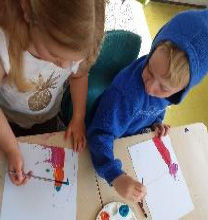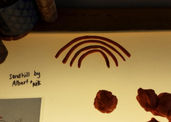
This term educators were questioning ‘ how are we fostering children’s cultural identity?’ ‘How do we embed Aboriginal and Torres Strait Islander perspectives in our curriculum?’
We know that our children come from diverse backgrounds and that each family is unique in their culture and family traditions and ways of knowing, however, we felt that cultural richness and differences were not necessarily fostered through our current curriculum.
Sharing a picture book about our diverse Australian society we asked the children about their family heritage when asked “Who is Australian?” most children responded “not me!” The children did not have a strong connection with being Australian but they knew they were from ‘Mount Gambier’ or ‘Port Mac’ or ‘Moorak’.
These observations informed the room curriculum and educators began sharing stories about diversity and sharing uniqueness. This instigated many discussions with the children, illustrating what they knew and the questions they held.



that's the firework flag -
Walter looking at the union Jack on the Australian flag and contemplating the yellow sun on the aboriginal flag
And that's the heart flag


Looking at the aboriginal Australia map, children could not locate where they live on the map but instead connected emotionally with the colours. pointing out colours they liked and saying "I live here"


-Hypothesis -
Children understand that
symbols are a powerful means
of communication
Enquiry Question-
What colours and symbols do
children choose to represent
themselves as a collective
group?

The project was challenging to orchestrate, in the sense that educators identified that the children explored the concepts presented to them at differing paces. The diverse group of learners did however firmly recognize their identity as a group, and named themselves.


We first delved into the children’s own identity, reading a story about uniqueness and reflecting on a colour that best revealed something about their own identity.
Throughout the discussion the children began with the colour that best represents their identity. What was interesting was that the colour took over the page. No longer was it just portraits, the colours spilled out from the children as a hidden identity to be seen, to be noticed.



The children believe their
colour stays the same
everywhere they go
‘No, I’m always
red/blue/rainbow’
‘At home I’m a
rainbow’

Something we explored throughout was listening to the ideas and perspectives of others. All the children were respectful to others' ideas even if they did not necessarily agree with them. This showed me that they could demonstrate an underlying acceptance of differences and that children understand that there are often many different perspectives around single issues.
What I found complex, however, was encouraging the children to collaborate artistically. When asking the children to examine their own identity, it was difficult to get them to think about identity as a whole and represent the ideas of the collective group. Strong identities shone through, each wanting to complete individual pictures and paintings.
In the future it would be advantageous, to explore the concepts further giving the children the chance to further promote the views as they began to collaborate, highlighting the process of democracy and the rights and responsibilities we bear as members of society.


Fundamental to our society is sharing knowledge through stories. Sharing Annie's story ( by Aunty Michelle Jacquelin-Furr) and exploring the symbols used to show Annies journey peaked the children's interest immensely. A strong connection to the symbol of the lake was formed.
Children could see the picture of the blue lake, they all have living memories of the lake, it is an icon to Mount Gambier. The symbols were used repeatedly in the art from this point onwards.
Piper had an especially strong connection with this.
Children were showing a keen interest in using symbols in their art. Of course, we know that children use symbols to make meaning from a very young age.
What may look like a scribble to an onlooker was certainly done with intention to communicate a message.
But now it was almost like a secret code, once they knew what it meant; they took pride in using it with intention and sharing their knowledge with others.
The children were developing a shared language. An agreed system of colours and symbols that they all recognised and used to be included and part of the culture of the village.

Strong in their ideas, the children contribute to our culture by sharing their ideas, knowledge and experience with us to both be seen and to be part of our culture.
Time was passing by so quickly and opportunities for the children to come together and work on a common artwork to represent their ideas was not successful.
I felt more time was needed to collaborate as a group and create a strong group identity. I was confident that each child
could express their own ideas each week that we came together but they needed more time to feel comfortable if they were going to collaborate successfully.
Recognising this, I presented the children with the opportunity to contribute individually to a shared piece of art - a flag of sorts to display in our room.
Each child had their own square to work with, still individual, but brought together to make a collaborative piece. The children were extremely eager to be a part of it, asking if it was their turn to create their piece of the flag yet.
Children feel a sense of belonging when their language, interaction styles and ways of communication are valued
- Early Years Learning Framework



Children feel a sense of belonging when their language, interaction styles and ways of communication are valued - Early Years Learning Framework
Children develop an understanding that symbols are a powerful means of communication and that ideas, thoughts and concepts can be represented through them
-Early years learning framework
As the final art piece was nearing completion, the children were gaining a sense of the power and influence they have in the world.
I asked them ..."What will people say when they see your flag"?
The children replied .....
“They will know it's us”






















